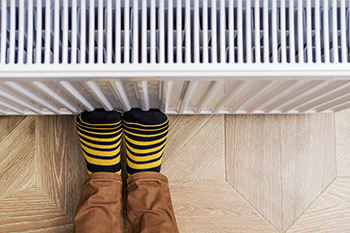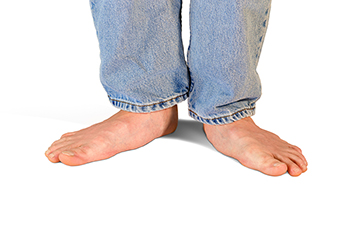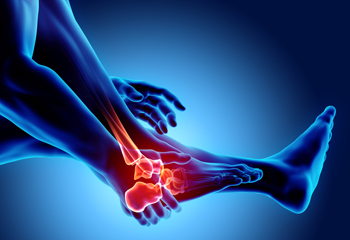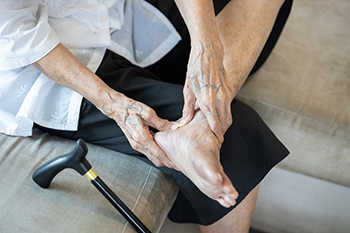Items filtered by date: November 2023
The Definition of Trench Foot

Trench foot, or immersion foot, is a condition resulting from prolonged exposure to wet and cold environments. It can occur even in temperatures as high as 60 degrees, especially if the feet remain constantly wet. This happens because wet feet lose heat much faster when compared to dry feet. To preserve body heat, the body reduces blood circulation to the feet, leading to a lack of oxygen and essential nutrients in the foot tissues. This process can cause the death of skin tissues due to the absence of these vital elements and the accumulation of toxic substances. The symptoms of trench foot include a reddening of the skin, numbness, and a tingling sensation that can be painful. Swelling often occurs, and in more severe cases, blisters, ulcers, or bleeding under the skin may develop. One of the most severe symptoms is gangrene, where the foot can turn dark purple, blue, or gray. If you are suffering from trench foot, it is important to remove wet footwear and socks immediately, dry the feet thoroughly, and avoid walking on the affected feet to prevent further tissue damage. For help, it is suggested that you make an appointment with a chiropodist for an examination and any necessary treatment.
Fall is a time of increased outdoor activities, sports, and back-to-school events. It can also be a time of increased foot and ankle problems. For all of your autumn foot care needs, please consult with Emily Yu, B.Sc from Uptown Foot Care Clinic. Our specialist can help you maintain the health of your lower limbs and your mobility.
Common foot and ankle problems that can arise during the fall season include:
Bunions - Bony growths on the outsides of the big toe joints
Hammertoes - Toe deformity that causes the toe to bend downward at the middle joint
Plantar fasciitis - Inflammation of the ligament that runs along the bottom of the foot
Achilles tendonitis - Inflammation of the tendon that runs along the back of the calf
Sever’s disease - Injury to the growth plates of the heel bones, common in children and teens
Metatarsalgia - General foot pain
Blisters - Skin lesions usually caused by friction over an area of skin
Sesamoiditis - Injury to the tiny, pea-shaped bones located just beneath the big toe
Many of these conditions are associated with increases in physical activity of the change from wearing flimsy summer shoes to more sturdy fall shoes. If you have any questions, please feel free to contact our office located in . We offer the newest diagnostic and treatment technologies for all your foot care needs.
Symptoms and Treatment for Flat Feet

Flexible flat feet, a prevalent condition beginning in childhood and sometimes extending into adulthood, is characterized by the partial or total collapse of the arches. A flat foot is normal in infants and toddlers due to the underdevelopment of the arch. In adults, flexible flat feet symptoms can include pain in the heel, arch, ankle, or along the outside of the foot. Some people may also experience a rolled-in ankle, shin splints, general aching or fatigue in the foot or leg, as well as referred pain in the low back, hip, or knee. Treatment options include reducing weight-bearing activities that cause pain and avoiding prolonged walking and standing. Weight loss is also recommended to reduce strain on the arches. Wearing custom-made full functional orthotic devices can provide essential arch support, aid in alignment, and reduce discomfort. In severe cases, immobilization through a walking cast or complete avoidance of weight-bearing may be necessary. Ultrasound therapy and other modalities can offer temporary relief. Additionally, wearing supportive shoes is essential for individuals with flexible flat feet, as appropriate footwear contributes to overall foot health. For help with conditions stemming from flat feet, it is suggested that you make an appointment with a chiropodist.
Flat feet are a common foot condition. If you are experiencing pain or discomfort due to flat feet, please consult with Emily Yu, B.Sc from Uptown Foot Care Clinic. Our specialist will assess your condition and provide you with quality foot and ankle treatment.
What Are Flat Feet?
Flat feet are feet that do not have a well-defined arch in the middle of the sole of the foot. Flat feet may be flexible or rigid. Flexible flat feet have an arch when there is no pressure put on the foot, such as when one is sitting, but the arch disappears upon standing. Rigid flat feet lack an arch regardless of whether one is standing or not.
Causes
Flat feet can be present from birth or acquired over time due to a weakening of the ligaments in the arch. Sometimes flat feet are caused by illnesses, injuries, or pregnancy.
Symptoms
Flat feet often cause no noticeable symptoms. However, some people may experience pain and discomfort due to their flat feet.
Symptoms associated with flat feet include:
Pain in the arch, heel, ankle, or along the outside of the foot
Overpronation of the foot
Shin splints
Aching or fatigue in the feet or legs
Pain in the knees, hips, or lower back
Treatment
In cases where flat feet cause symptoms, there are various treatments available. Wearing orthotic inserts in your shoes to provide more arch support, performing stretches, and taking medications may improve your symptoms. If you are overweight, losing weight can help relieve pressure on the feet. In severe cases, surgery may be considered.
If you have any questions, please feel free to contact our office located in . We offer the newest diagnostic and treatment technologies for all your foot care needs.
Foot Arthritis and Cold Weather

For people with foot arthritis, winter can bring about intensified joint pain. While osteoarthritis involves cartilage breakdown, rheumatoid arthritis is characterized by the immune system attacking joint linings. Management of arthritis aims to lessen symptoms and maintain quality of life. Some theories suggest that drops in barometric pressure with cold weather may cause tissues to expand, possibly leading to heightened pain. Research indicates that women may experience more severe pain in colder temperatures, and vitamin D deficiency during the winter months could also contribute to more intense symptoms. If you suffer from arthritis and you feel foot and ankle pain in the winter months, it is suggested that you make an appointment with a chiropodist who can help you find relief.
The winter months can bring about new or worsening foot and ankle problems. If you’re suffering from foot or ankle pain, please consult with Emily Yu, B.Sc from Uptown Foot Care Clinic. Our specialist can help you maintain the health of your lower limbs and your mobility.
Winter Foot Problems
Cracked heels - Dry, cracked skin on the heels of the feet that is associated with cold, dry weather
Athlete’s foot - A fungal infection on the skin of the feet
Blisters - Fluid-filled bubbles of skin that usually form in response to friction
Fractures - Broken bones in the feet or ankles
Metatarsalgia - General foot pain
Chilblains - Spasming of the small blood vessels in the toes in response to exposure to cold weather
Raynaud’s disease - Numbness, pain, and color changes in the toes due to cold weather
Prevention
Wear warm socks and shoes
Avoid prolonged exposure to the cold
Moisturize the heels regularly
Keep your feet clean and dry
Walk carefully in areas that may be icy
Wear non-slip shoes
If you have any questions, please feel free to contact our office located in . We offer the newest diagnostic and treatment technologies for all your foot care needs.
Keep Your Feet Healthy So You Can Stay Active
How Aging Can Affect the Feet

Taking good care of your feet as you age is both a matter of comfort and a way for you to stay active and mobile. Your feet are often considered mirrors of your overall health. Any unusual or persistent changes in your feet may be indicative of underlying health conditions, including dry skin, brittle nails, and burning or tingling sensations. For those who have difficulty caring for their feet or lack assistance from family members, regular check-ups with a chiropodist are strongly suggested. Prolonged neglect of foot issues, such as overgrown nails, can lead to infections, and for individuals with diabetes, this poses a higher risk as they age. Infections can potentially lead to more serious illnesses, emphasizing the importance of early intervention and proper foot care. Aging may bring changes to your feet, but with daily foot care and regular visits to a chiropodist, you can enjoy good foot health and continue to lead an active, mobile, and fulfilling life. For the best care of your feet, or to address any current foot conditions, it is suggested that you make an appointment with a chiropodist.
Foot problems can become increasingly common as we age, making everyday foot care especially important. To learn more about maintaining proper foot health, please consult with Emily Yu, B.Sc from Uptown Foot Care Clinic. Our specialist will assess your condition and provide you with quality foot and ankle treatment.
Common Foot Problems
Certain foot problems may be more likely to affect older adults.
Some examples of foot conditions that can be common in older adults include:
Dry, cracked skin
Calluses and corns
Blisters
Ingrown toenails
Deformities such as bunions or hammertoes
Fungal infections
Plantar warts
Systemic conditions, such as diabetes or arthritis, are also more likely to affect older people and manifest symptoms in the feet and ankles.
Daily Foot Care Tips
Having a daily foot care routine can help detect problems early on and prevent future issues.
Things that you can do at home to care for your feet include:
Washing the feet daily with warm water, drying them thoroughly, and then applying a moisturizer
Trimming the toenails straight across and not too short to prevent ingrown toenails
Performing daily foot exercises to improve foot strength and mobility
Wearing shoes when walking to avoid injury
Inspecting the feet daily for any cuts, scrapes, sores, or other abnormalities and seeking prompt treatment if any problems are discovered
If you have any questions, please feel free to contact our office located in . We offer the newest diagnostic and treatment technologies for all your foot care needs.

